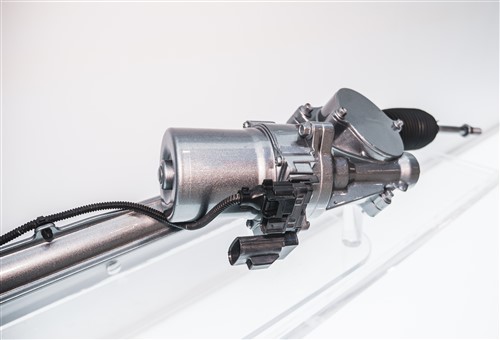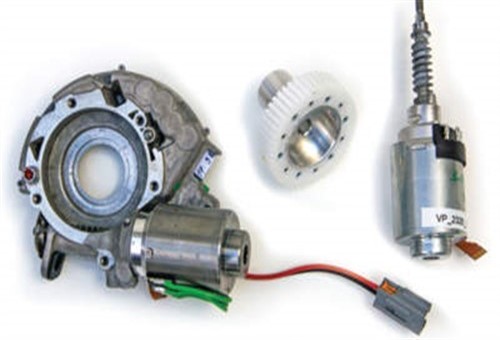
Electric power steering systems have been with us for many years, and if we consider these systems in their simplest form, they are, for the most part, fairly robust and reliable. However, the operative words in the above statement are "for the most part" because unlike the basic electric steering systems on most other vehicle makes, the electric power steering systems on General Motors products can be finicky, troublesome, and downright problematic in terms of the kinds of failures and symptoms that are common on especially, older GM products.
In this article, then, we will take a closer look at GM electric power steering systems in their basic form i.e., divorced from their ADAS-oriented add-ons, as well as provide some diagnostic tips and tricks that apply to both older and newer electric power steering systems on GM products. Before we get to specifics, though, we should perhaps take a step back and consider the operating principles of-
Pre-ADAS electrical power steering systems on GM products were relatively simple; a steering angle sensor detected the motion of the steering wheel, as well as how fast the steering wheel was being turned, and a control module then calculated the amount of steering assist required based on the vehicle’s road speed at that moment. So, the lower the vehicle’s road speed at any given moment, the more steering assistance the system would provide, although the correlation between the movement of the steering wheel and the actual steering angle would remain constant at all road speeds.
Up to this point, there was not much difference between how electric power steering worked on GM products and how electric power steering worked on other vehicle makes. However, what made GM’s electric power steering system stand out was the fact that GM’s system had four distinctly separate operating modes that sometimes overlapped during operation, and although electric power steering systems on other vehicle makes also used different operating modes, the interface between operating modes on older GM products failed more often on GM products than on other makes.
Below are some details of GM’s operating modes-
Normal mode
In this mode, the steering angle and torque sensors provide input data on the steering wheel’s movement to the steering control module, which then calculates the amount of steering assist required based on the vehicle’s road speed at that moment.
This system worked well enough when the vehicle was new. However as these vehicles aged, the effects of mechanical wear in steering system components, combined with the lack of resolution of input data and steering control modules’ limited ability to compensate for the progressive loss of sensor sensitivity sometimes produced imprecise steering responses at low to moderate road speeds when large amounts of steering assist were required.
Return mode
This mode uses the steering position sensor’s movement back towards the straight-ahead position after exiting a turn to calculate the amount of steering assistance required to return the front wheels to the straight-ahead position, without overshooting the straight-ahead position.
However, in practice, the loss of sensitivity of the steering angle sensor and/or the steering torque sensor sometimes caused the steering control module to over or undershoot the straight-ahead position.
Damping mode
This mode acts like a hydraulic damper to prevent bump steer and steering kick-back on uneven road surfaces by using input data from the steering wheel’s position sensor to calculate a small amount of counter steer to eliminate steering kick-back.
Sometimes, though, the steering system entered this mode even when the vehicle was stationary with the engine running, which if it happened, produced small, but noticeable and slightly disconcerting movements of the steering wheel. As far as this writer is aware, the reasons why this mode sometimes engaged by itself have never been determined with any degree of certainty.
Self-protection mode
This was perhaps the most important mode because it detected conditions that could cause the steering motor to overheat or burn out. Typical causes of overheating included keeping the steering at full lock for longer than a few seconds, turning from full lock to opposite full lock repeatedly, or a defective steering angle sensor that provided incorrect or inaccurate input data to the steering control module.
More importantly, though, the steering motor could also overheat as a result of driving on excessively cambered roads for extended periods, because excessive road camber forces the steering motor to provide a near-constant measure of counter-steering to combat the vehicle's tendency to drift off the cambered road surface, which brings us to-

The biggest problem with electric power steering systems dating from the late 1980s was a combination of two separate, yet linked problems. The first was a lack of sufficient computing power to run complex self-diagnostic tests, and the second was the low resolution of sensor input data.
One example of this involved poorly calibrated steering angle sensors, on the one hand, and the loss of sensor sensitivity caused by the long use of these sensors, on the other hand. Since the limited self-diagnostic abilities of control modules from this time could often not distinguish between poor calibration and loss of sensor sensitivity, steering control modules typically took the route of disabling electric power steering systems when they detected faults they could not categorise definitively.
So, from a diagnostic perspective, the biggest challenge technicians from this era had was the fact that they were almost always presented with electric power steering systems that were disabled for reasons that the test equipment of the time could not determine.
Bear in mind that from 1988 when OBD I was introduced, and 1991, when at least some standardisation of OBD 1 regulations were introduced (but hardly ever enforced), automotive diagnostics was very often a guessing game because trouble codes, and especially generic communications codes as we know and understand them today did not yet exist. Trouble codes that meant the same thing(s) for everyone were only introduced in 1996 when the OBD II standard was introduced, which means that before 1996, any technician’s guess about why a power steering system on any given GM product was disabled by a control module was as good as any other technician’s guess.
We could say a lot more about the weaknesses of electric power steering systems on older GM products, but it would perhaps be more productive to discuss some aspects of the-
The latest iteration(s) of electric power steering systems should really be referred to as “electronically controlled” steering systems. This is because although the latest systems use largely the same types of components that older systems used, what sets the latest versions apart from their predecessors is a) their very deep integration into several ADAS systems and b) the very high resolution of the input data modern systems use to calculate steering assist levels.
We covered these integrations in a previous article titled “A New Look at Electronic Power Steering Systems”, so for the purposes of this article, we can dispense with the ADAS-related aspects of modern GM power steering systems and focus on the principal components of these systems, instead, starting with-
Modern power steering motors

Modern motors are fully reversible brushless DC units that provide steering assist through a set of worm gears, one of which is made of plastic, as shown above.
Note though that while the brushless design of these motors is new, modern power steering motors on GM products still cannot cope with long duty cycles. What this means in practice is that holding the steering at full lock for longer than about ten seconds, or turning from full lock to full lock multiple times in quick succession while the vehicle is not moving will still cause the motor to overheat. However, unlike older systems that will deactivate automatically when the steering assist motor overheats, modern systems will reduce the current to the motor until it cools down to below a maximum allowable threshold.
As a practical matter, reducing electrical current to the steering assist motor will reduce the steering assistance provided until the motor has cooled down sufficiently to resume normal operation. This is a typical operating feature of modern GM power steering systems, and it helps to keep this feature in mind when customers complain of "tight", “difficult”, or reduced steering assistance at what is to them, random times.
Modern steering torque sensors
Unlike older GM power steering systems that used primary input data from the steering angle sensor to calculate required steering assist, modern systems use steering torque sensors to provide primary input data about the steering angle and the amount of steering assist that is required at any given moment.
As a practical matter, modern GM steering torque sensors are 5-volt, dual analog inverse signal devices, which, essentially, means that these sensors contain two counter-rotating rotors that operate at voltages between 0.25V and 4.75V. Voltages outside of this range will usually, but not always, set sensor performance or sensor out-of-range trouble codes.
In practice, turning the steering wheel creates two signal voltages that are labelled Signal Voltage 1 and Signal Voltage 2. If, for instance, the steering wheel turns to the left, signal voltage 1 will decrease while signal voltage 2 will increase by the same amount, and vice versa. The power steering control module interprets the changing voltages as changes in both the steering direction and steering shaft torque applied and provided the changes in both signal voltages remain within an extremely narrow range, the power steering control module will consider the steering system to be free of faults and defects.
However, if the variance between signal voltage 1 and signal voltage 2 exceeds a precisely defined threshold, the power steering control module will illuminate a dedicated warning light and may reduce current flow to the power steering assist motor or deactivate the power steering system altogether, depending on the magnitude of the signal voltage variance.
Steering wheel position sensor
Modern GM power steering systems use dedicated 5-volt, dual analog sensors that operated between 0V and 5V to monitor the position of the steering wheel relative to the straight-ahead position as calculated and reported by the steering torque sensor.
Provided that-
- the steering wheel position sensor will calculate the steering wheels’ straight-ahead position, and provide limited steering assistance to return the front wheels to the straight-ahead position as the vehicle exits a turn.
While older GM power steering systems used similar sensors to do much the same thing, the resolution of modern steering wheel position sensor data is several orders of magnitude greater than was the case with older iterations of this sensor. This fact, coupled with the increased computing power of (power steering) control modules and faster communication networks means that it is unlikely that the steering wheel on a modern GM product will under or overshoot the straight-ahead position.
However, this assumes that-
If any of the above conditions are not met, the steering wheel position sensor may not provide assistance to return the front wheels to the straight-ahead position, which if it happens, could mean that drivers are caught unawares when the vehicle takes longer to exit turns than they used to. Moreover, note that on some modern GM products, a driver has to steer the vehicle out of corners manually when the steering wheel position sensor stops working, which to some drivers, might appear to be a “catastrophic” or “total” power steering system failure, which brings us to-
High-resolution input data, more sensors, and improved computing power all combine to enhance modern power steering systems on GM products in terms of both performance and self-diagnostics. Moreover, the combination of improved input data and more sensors also makes it easier for us as technicians to diagnose modern GM power steering systems.
However, the improved abilities and increased complexity of modern GM power steering systems do not necessarily translate into increased system reliability; in fact, it could be argued that modern GM power steering systems are no more reliable than their predecessors dating from the early 2000s.
One example of this will suffice, so consider the case of GM Technical Service Bulletin TSB 07-02-32-007B, which was first published in August of 2009, and applied to issues on early electric power steering systems on a wide range of GM products. Briefly, the TSB addresses several issues, but here is a direct quote from the bulletin-
SUBJECT: “Diagnostic Tips for Power Steering Inoperative/Steering Wheel Hard to Turn, Power Steering Message Displayed on DIC, DTCs C0176, C0475, C0476, C0550, U2105, U2107 Set."
MODELS AFFECTED: 2005 2010 Chevrolet Cobalt
The TSB goes on to describe some diagnostic tests and tips to resolve the listed codes, but here’s the thing- some of the same codes are also set on late-model GM products, which means that many of the same issues persist on new GM vehicles. Note, though that although not all of the diagnostic tips provided in the above TSB apply to new GM products, modern scan tools with bidirectional controls can take some of the pain out of diagnosing old problems on new GM vehicles.
Nonetheless, here are some things to look out for when you are presented with power steering issues on late-model and new GM products-
Wheel alignment issues
It has been this writer’s experience that many GM products seem to be significantly more sensitive to the effect of poor wheel alignment(s) than most other vehicle makes. This is borne out by the fact that when steering torque sensor calibrations abort repeatedly, or won’t complete successfully, minute adjustments to (especially) toe-in/toe-out settings will often resolve the calibration issue. In fact, the closer all wheel alignment settings are to OEM specs, the less likely it is that you will encounter steering-related sensor calibration issues.
Abnormal system voltages
Although abnormally low system/battery voltages affect different vehicles in different ways, it turns out that low battery voltages will usually/often affect the electronic power steering systems on late-model GM products to an inordinate extent before it affects other systems.
As a matter of fact, resolving low battery voltages will usually also resolve many power steering system trouble codes. However, be aware that in some cases, such as when a battery had run down completely, you may have to reprogram the power steering control module with the latest updates, fixes, and patches using a registered GM-specific scan tool* to get the power steering system to work as expected.
* This is required to get past the secure gateway modules that now feature on all GM products.
As a practical matter, it helps to remember that many power steering issues can and do stem from problems that do not actually involve the power steering system itself. Many steering-related trouble codes are often set as the result of communications failures between ADAS systems, so be sure to always interrogate all the control modules on the vehicle for trouble codes.
This can take up a lot of time, however, so this writer recommends that you use a scan tool that can display the layout of the various communications systems in the vehicle since doing this will indicate which modules are not communicating at a glance.
NOTE: If you need to disconnect the battery for any reason during a diagnostic process, be sure to wait for at least 25 seconds after switching the ignition off before disconnecting any battery terminal. Failing to do this will almost certainly cause not only the steering control module but also one or more other control modules to lose critical programming, which brings us to-
“Sneaky” problems
General Motors products are not the only ones that sometimes develop “sneaky” problems, but as far as this writer is aware, General Motors is the only manufacturer to have ever published a TSB that talks about mechanical noises that seem to emanate from the steering system, but actually originate elsewhere. Thus, consider TSB 04-03-08-006E, which stretches over 12 pages that cover several distinctly different mechanical noises that include clunks, thumps, rattles, knocking sounds, popping sounds, shudders, and an odd Vibration.
When this TSB, which incidentally, should be required reading by all independent mechanics and technicians, in 2012, it covered the following models-
However, TSB 04-03-08-006E has been revised several times since its first publication to include more GM models, but for the most part, the most common underlying causes of the various mechanical noises remain largely the same on all affected GM products. Here are some examples, as listed by the original version of the TSB-
Note that since the above list of possible causes o sounds that appear to come from the steering column is neither complete nor exhaustive, this writer recommends that you perform an exhaustive steering/suspension system inspection to eliminate (or confirm) worn suspension/steering system components as the cause of mechanical noises, which leaves us with this-
It is important to note that some actual problems in the steering column and the steering assist motor, such as excessive backlash between the worm gears, can create mechanical noises that strongly mimic the sounds that worn suspension components make over rough surfaces. Therefore, dismissing some mechanical noises as suspension noises could be a mistake since the problem might, in fact, involve critical steering system components.
Sadly, the only way to be sure about which is which, is to investigate all possible causes of mechanical noises thoroughly and with a super-critical eye to be sure you are addressing your customer's concerns adequately.